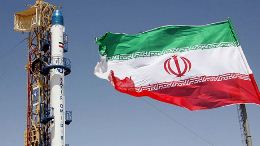 Iran announced on television Monday that it had marked the birthday of the Prophet Muhammed by successfully flying a monkey to space and back in a suborbital capsule which climbed to 120 kilometers. Defence Minister Ahmad Wahidi said manned missions are on his countryís plans.
Iran announced on television Monday that it had marked the birthday of the Prophet Muhammed by successfully flying a monkey to space and back in a suborbital capsule which climbed to 120 kilometers. Defence Minister Ahmad Wahidi said manned missions are on his countryís plans.
Dr Igor†Lisov is Deputy Editor-in-Chief of the Novosti Kosmonavtiki, or Space Flight News, journal:
"The Iranians are retracing the path trodden in the 1950s by the two pioneering space powers, the Soviet Union and the United States. They possess the necessary technology and, unlike some established space powers, are strongly motivated to advance it."
Director of the Moscow-based Social and Political Research Center Dr Vladimir Yevseyev tracks the progress of this advance:
"Iranís main booster rocket is Safir-2. It is relatively light, and all three Iranian satellites launched by it weighed less than 50 kilos. All other missions boosted by this rocket were suborbital. Another Iranian booster rocket, codenamed Simurgh, is much more powerful. Its first successful launch, however, is some way off. Interestingly, this rocket is very similar to the Unha-3 booster developed by North Korea."
Dr Yevseyev again:
"Last September, Iran and North Korea signed an agreement to cooperate in developing space and missile technologies. Many believe Iranian engineers watched the first launch of the Unha-3 in December. This means the first launch of the Simurgh rocket is not that far away."
Once the Simurgh booster is in service, Iran will be capable of launching satellites weighing up to 2 tons. It will also acquire ballistic missiles capable of carrying warheads to distances of several thousand kilometers.
Symptomatically, the announcement about the successful monkey spaceflight Monday coincided with Iranís statement that it will not accept further talks on its nuclear energy programme unless its negotiating partners recognize its right to enrich uranium to 20%. Iran apparently sees its missile capability as an instrument to protect this right.
By The Voice of Russia
The Iran Project is not responsible for the content of quoted articles.

 QR code
QR code